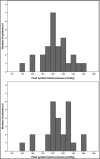The exaggerated blood pressure response to exercise in the sub-acute phase after stroke is not affected by aerobic exercise
- PMID: 29338111
- PMCID: PMC8031265
- DOI: 10.1111/jch.13157
The exaggerated blood pressure response to exercise in the sub-acute phase after stroke is not affected by aerobic exercise
Abstract
The prevalence of an exaggerated exercise blood pressure (BP) response is unknown in patients with subacute stroke, and it is not known whether an aerobic exercise program modulates this response. The authors randomized 53 patients (27 women) with subacute stroke to 12 weeks of twice-weekly aerobic exercise (n = 29) or to usual care without scheduled physical exercise (n = 24). At baseline, 66% of the patients exhibited an exaggerated exercise BP response (peak systolic BP ≥210 mm Hg in men and ≥190 mm Hg in women) during a symptom-limited ergometer exercise test. At follow-up, patients who had been randomized to the exercise program achieved higher peak work rate, but peak systolic BP remained unaltered. Among patients with a recent stroke, it was common to have an exaggerated systolic BP response during exercise. This response was not altered by participation in a 12-week program of aerobic exercise.
Trial registration: ClinicalTrials.gov NCT02107768.
Keywords: exercise/hypertension; lifestyle modification/hypertension; stroke; stroke prevention.
©2018 Wiley Periodicals, Inc.
Conflict of interest statement
The authors report no conflicts of interest.
Figures


References
-
- Cornelissen VA, Buys R, Smart NA. Endurance exercise beneficially affects ambulatory blood pressure: a systematic review and meta‐analysis. J Hypertens. 2013;31:639‐648. - PubMed
-
- Gordon NF, Gulanick M, Costa F, et al. Physical activity and exercise recommendations for stroke survivors: an American Heart Association scientific statement from the Council on Clinical Cardiology, Subcommittee on Exercise, Cardiac Rehabilitation, and Prevention; the Council on Cardiovascular Nursing; the Council on Nutrition, Physical Activity, and Metabolism; and the Stroke Council. Circulation. 2004;109:2031‐2041. - PubMed
-
- Nishioka Y, Sashika H, Andho N, Tochikubo O. Relation between 24‐h heart rate variability and blood pressure fluctuation during exercise in stroke patients. Circ J. 2005;69:717‐721. - PubMed
-
- Kurl S, Laukkanen JA, Rauramaa R, et al. Systolic blood pressure response to exercise stress test and risk of stroke. Stroke. 2001;32:2036‐2041. - PubMed
Publication types
MeSH terms
Associated data
LinkOut - more resources
Full Text Sources
Other Literature Sources
Medical

